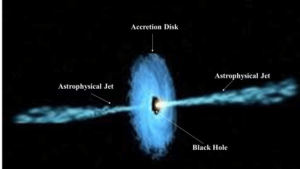Astrophysical Jets

- An astrophysical jet is an astronomical phenomenon where outflows of ionised matter are emitted as an extended beam along the axis of rotation.When this greatly accelerated matter in the beam approaches the speed of light, astrophysical jets become relativistic jets as they show effects from special relativity.
- The formation and powering of astrophysical jets are highly complex phenomena that are associated with many types of high-energy astronomical sources.
- They likely arise from dynamic interactions within accretion disks, whose active processes are commonly connected with compact central objects such as black holes, neutron stars or pulsars.
- One explanation is that tangled magnetic fields are organised to aim two diametrically opposing beams away from the central source by angles only several degrees wide (c. > 1%).Jets also be influenced by a general relativity effect known as frame-dragging.
- Most of the largest and most active jets are created by supermassive black holes (SMBH) in the centre of active galaxies such as quasars and radio galaxies or within galaxy clusters.Such jets can exceed millions of parsecs in length.
- Other astronomical objects that contain jets include cataclysmic variable stars, X-ray binaries and gamma-ray bursts (GRB).
What are Relativistic Jets ?

- Relativistic jets are beams of ionised matter accelerated close to the speed of light.
- Most have been observationally associated with central black holes of some active galaxies, radio galaxies or quasars, and also by galactic stellar black holes, neutron stars or pulsars.
- Beam lengths may extend between several thousand, hundreds of thousands or millions of parsecs.
- Jet velocities when approaching the speed of light show significant effects of the special theory of relativity; for example, relativistic beaming that changes the apparent beam brightness.
- Massive central black holes in galaxies have the most powerful jets, but their structure and behaviours are similar to those of smaller galactic neutron stars and black holes.
Indian Institute of Astrophysics
- Headquarters: Bengaluru
- The institute has a network of laboratories and observatories in India as following
- Kodaikanal – the Kodaikanal Solar Observatory
- Kavalur – the Vainu Bappu Observatory,
- Gauribidanur – the Gauribidanur Radio Observatory,
- Hanle – the Indian Astronomical Observatory
Significance Of IIA
- IIA conducts research primarily in the areas of astronomy, astrophysics and related subjects.
- It is widely recognized as a leading research center for astrophysics in India.
- IIA contributed to Astrosat, India’s first dedicated multi-wavelength space observatory.
- The institute led the development of Ultraviolet Imaging Telescope (UVIT).
Black Hole
- Black holes – tears in the fabric of space-time from which no light can escape, are among the most exotic objects in the Universe. Many black holes form naturally through stellar evolution, as remnants left over by the collapse of massive stars.
Supermassive black holes – millions to a billion times our Sun’s mass – that grow in the hearts of galaxies over cosmic time by ‘swallowing’ surrounding dust and gas, entire stars, and even other black holes.
















